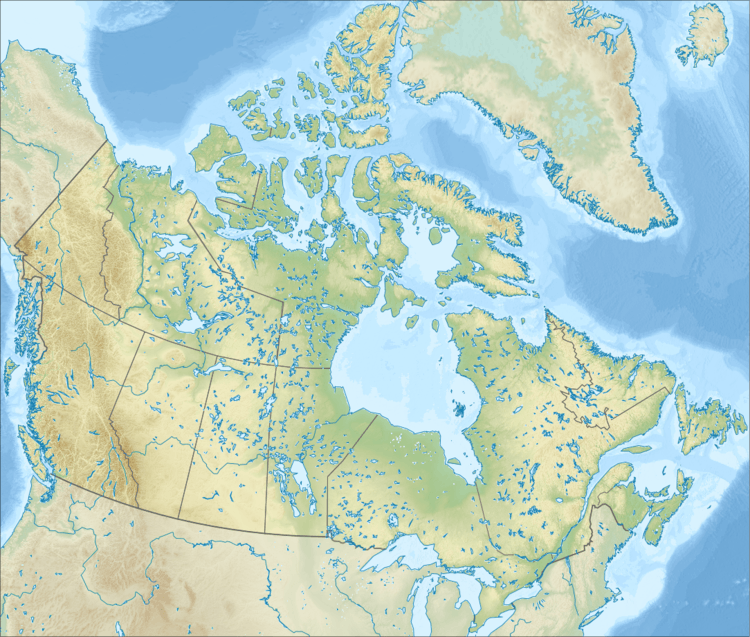Mount Jimmy Simpson
Mount Jimmy Simpson is a 2,966-metre (9,731-foot) summit located 3 kilometres (1.9 miles) northwest of Bow Lake in Banff National Park, in the Canadian Rockies of Alberta, Canada. Its nearest higher peak is Mount Thompson, 3.0 km (1.9 mi) to the southwest.[2] Mount Jimmy Simpson is a member of the Waputik Mountains, and is situated east of the Wapta Icefield and west of the Bow River valley. Mount Jimmy Simpson can be seen from the Icefields Parkway at Bow Lake. Jimmy Simpson Junior is a 2,721 meter sub-summit east of the mountain.
| Mount Jimmy Simpson | |
|---|---|
 Mt. Jimmy Simpson in winter (2013) | |
| Highest point | |
| Elevation | 2,966 m (9,731 ft) [1] |
| Prominence | 251 m (823 ft) [2] |
| Parent peak | Mount Thompson (3089 m)[2] |
| Listing | Mountains of Alberta |
| Coordinates | 51°41′08″N 116°30′17″W [3] |
| Geography | |
 Mount Jimmy Simpson Location of Mount Jimmy Simpson in Alberta  Mount Jimmy Simpson Mount Jimmy Simpson (Canada) | |
| Location | Alberta, Canada |
| Parent range | Waputik Mountains Canadian Rockies |
| Topo map | NTS 82N10[3] |
| Geology | |
| Age of rock | Cambrian |
| Type of rock | Sedimentary |
| Climbing | |
| First ascent | 1897 by J. Norman Collie, G.P. Baker, P. Sarbach[4] |

History
Mount Jimmy Simpson is named for Jimmy Simpson (1877–1972) who was a respected outfitter in the early explorations of the Canadian Rockies.[2] Jimmy worked as a cook for Tom Wilson and learned the guide and outfitting business from Bill Peyto. In 1902, while working for Peyto, he was given the responsibility of leading James Outram's climbing expedition into the headwaters of the North Saskatchewan River and Columbia Icefield.[4] Jimmy built a small log cabin for use with his outfitting business on the north shore of Bow Lake. It was expanded in 1937, and is now the historic Num-Ti-Jah Lodge. Jimmy continued actively guiding until the end of World War II when his son, Jimmy Simpson Junior, took over the business.[2]
The first ascent of Mount Jimmy Simpson was made in 1897 by J. Norman Collie, George Percival , and Peter Sarbach.[4] The mountain's name was officially adopted in 1973 by the Geographical Names Board of Canada.[3]
Geology
Like other mountains in Banff Park, Mount Jimmy Simpson is composed of sedimentary rock laid down during the Precambrian to Jurassic periods.[5] Formed in shallow seas, this sedimentary rock was pushed east and over the top of younger rock during the Laramide orogeny.[6]
Climate
Based on the Köppen climate classification, Mount Jimmy Simpson is located in a subarctic climate with cold, snowy winters, and mild summers.[7] Temperatures can drop below −20 °C with wind chill factors below −30 °C. Precipitation runoff from Mount Jimmy Simpson drains into the Bow River which is a tributary of the Saskatchewan River.
References
- "Mount Jimmy Simpson, Alberta". Peakbagger.com. Retrieved 2019-10-09.
- "Mount Jimmy Simpson". Bivouac.com. Retrieved 2018-10-21.
- "Mount Jimmy Simpson". Geographical Names Data Base. Natural Resources Canada. Retrieved 2018-10-21.
- "Mount Jimmy Simpson". PeakFinder.com. Retrieved 2019-10-09.
- Belyea, Helen R. (1960). The Story of the Mountains in Banff National Park (PDF). parkscanadahistory.com (Report). Ottawa: Geological Survey of Canada. Archived (PDF) from the original on 2015-10-02. Retrieved 2019-09-13.
- Gadd, Ben (2008). Geology of the Rocky Mountains and Columbias.
- Peel, M. C.; Finlayson, B. L. & McMahon, T. A. (2007). "Updated world map of the Köppen−Geiger climate classification". Hydrol. Earth Syst. Sci. 11: 1633–1644. ISSN 1027-5606.
External links
- Weather forecast: Mount Jimmy Simpson
- Parks Canada web site: Banff National Park
.jpg)